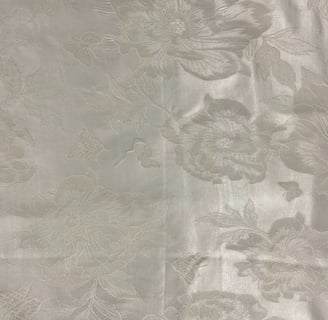Jacquard Fabric Weaving Process
Jacquard fabrics are highly regarded for their intricate patterns and textures, and their weaving process differs from that of regular fabrics, relying heavily on the precise control of Jacquard looms. With Jacquard looms, each warp thread can be individually raised or lowered to create intricate patterns. Understanding the weaving process of Jacquard fabrics helps appreciate the complexity and craftsmanship involved.
CC Textile WeChat: CC-Jacquard WhatsApp:+86 15306267080
10/2/20241 min read


Designing the Pattern
The production of Jacquard fabric begins with designing the pattern. Designers typically use specialized software to create intricate geometric shapes or floral designs. The detail and precision of the pattern directly affect the quality of the final fabric. Each pattern is translated into a program recognizable by the Jacquard loom.
Preparing Warp and Weft
During the weaving process, the warp and weft materials must be prepared in advance. Common fibers like cotton, polyester, and silk are often used. The warp threads are mounted on the loom, while the weft threads are interwoven during the weaving process.
Setting Up the Jacquard Loom
The Jacquard loom is the key equipment in this process. Through the Jacquard mechanism, each warp thread can be individually controlled, allowing the loom to precisely weave the pre-designed pattern. Setting up the loom includes arranging the warp threads, programming the pattern, and adjusting the weaving speed.
Beginning the Weaving Process
As the weaving process begins, the Jacquard loom raises and lowers the warp threads step by step according to the pre-set pattern, while the weft threads are inserted in a defined sequence. This process requires precise control to ensure the pattern is clear and correctly aligned. Due to the complexity of Jacquard fabrics, the weaving speed is slower than that of regular fabrics.
Post-Weaving Finishing
After the weaving is completed, Jacquard fabrics typically undergo post-finishing treatments, such as dyeing, waterproofing, or smoothing, to enhance the durability and appearance of the fabric. These treatments can be customized according to the customer’s requirements.
Quality Inspection
Finally, the woven fabric undergoes a thorough quality inspection to ensure the pattern’s integrity, weaving precision, and the absence of defects. This step is crucial for producing high-quality Jacquard fabrics.
Get in touch
Address
Suzhou CC Textile Co.,LTD
4101 West Ring 2nd Road, Shengze Town, Wujiang District, Suzhou, Jiangsu Province, China
ZIP Code:215228
